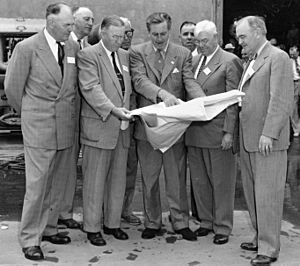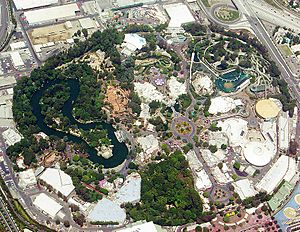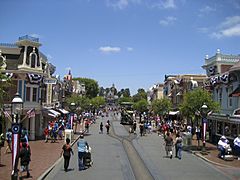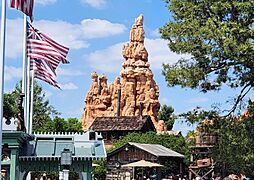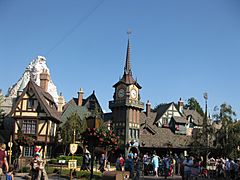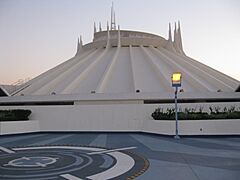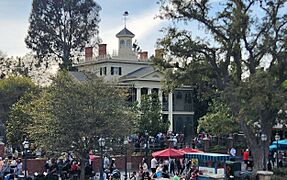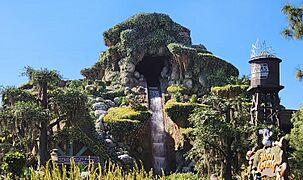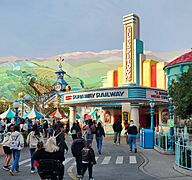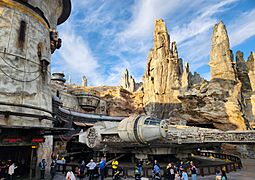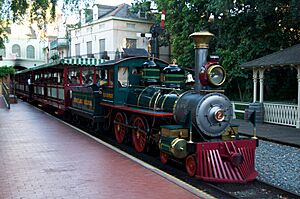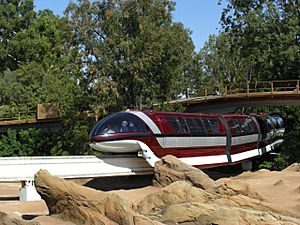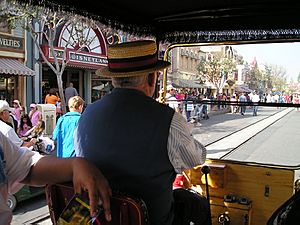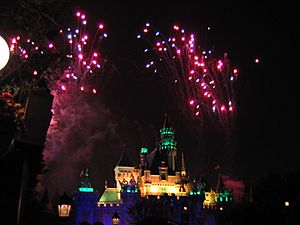Disneyland facts for kids
 |
|
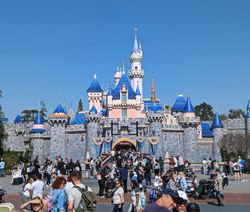
The park's icon, Sleeping Beauty Castle, in 2024
|
|
| Lua error in Module:Infobox_mapframe at line 185: attempt to index field 'wikibase' (a nil value). | |
| Location | Disneyland Resort, Anaheim, California, United States |
|---|---|
| Coordinates | 33°49′N 117°55′W / 33.81°N 117.92°W |
| Status | Operating |
| Opened | July 17, 1955 |
| Owner | Disney Experiences (The Walt Disney Company) |
| Operated by | Disneyland Resort |
| Theme | Disney characters and fairy tales |
| Slogan | The happiest place on earth |
| Operating season | Year-round |
Disneyland is a super fun theme park located in Anaheim, California, in the United States. It was the very first theme park opened by the Walt Disney Company. What makes it extra special is that Walt Disney himself helped design and build it. Disneyland first opened its gates on July 17, 1955.
Walt Disney first dreamed of building a place for fans near his studios. But he soon realized that space was too small for all his big ideas. After some research, Disney bought a large piece of land near Anaheim in 1953. A creative team chosen by Walt designed the park. They formed WED Enterprises, which is now called Walt Disney Imagineering. Construction started in 1954. The park opened with a special TV event on July 17, 1955. Since then, Disneyland has grown a lot. New areas like New Orleans Square (1966), Bayou Country (1972), Mickey's Toontown (1993), and Star Wars: Galaxy's Edge (2019) have been added. Also, Disney California Adventure Park opened in 2001 next to Disneyland.
Disneyland has welcomed more visitors than any other theme park in the world. Over 757 million people have visited since it opened. In 2023, 17.25 million people visited. This made it the second most visited park that year, right after Magic Kingdom in Florida.
History
How Disneyland Began
The idea for Disneyland started when Walt Disney was at Griffith Park with his daughters. He watched them on a merry-go-round and imagined a place where families could have fun together. This dream stayed with him for many years. Walt first wrote down his ideas in 1948. He called it "Mickey Mouse Park." He was inspired by places like Greenfield Village and the Chicago Railroad Fair.
People often wrote to Disney asking to visit his movie studios. Walt realized a studio wasn't very exciting for visitors. So, he started thinking about building a small park near his Burbank studios. His ideas grew to include boat rides and different themed areas. The first park idea was for a 16-acre plot. Besides Greenfield Village, Walt was also inspired by Tivoli Gardens in Denmark and Knott's Berry Farm.
His designers worked on these ideas, but the project quickly became too big for the small plot of land. Disney hired experts to find the best location for his theme park. Based on their advice, Disney bought 160 acres of land in Anaheim in 1953. This was southeast of Los Angeles.
Getting money for the park was a challenge. So, Disney decided to create a TV show called Disneyland. It aired on the ABC network. In return, ABC helped pay for the park. For its first five years, Disneyland was owned by several companies, including Walt Disney Productions and ABC. By 1960, Walt Disney Productions owned all the shares.
Construction began on July 16, 1954. It cost $17 million, which is like $190 million today. The park opened just over a year later. A major highway, Interstate 5, was also being built nearby. Extra lanes were added to handle the many visitors expected at Disneyland.
Opening Day Challenges
Disneyland had a special "International Press Preview" on Sunday, July 17, 1955. Only invited guests and media were supposed to attend. But 28,000 people showed up! About half of them had fake tickets or snuck in. The next day, the park opened to the public with twenty attractions. The Sunday event was shown live on TV. Famous hosts like Art Linkletter and Ronald Reagan were there.
It was a very hot day, about 101°F (38°C). There was a plumbers' strike, so Walt chose to have working toilets instead of drinking fountains. Many guests were thirsty. This caused some complaints, as people thought it was to make them buy soda. The fresh asphalt was so soft that women's high heels sank into it. Some parents even lifted their children over the crowds to get them on rides. Walt Disney and his team later called this day "Black Sunday." After the difficult opening, Walt invited guests back for a better experience.
At first, July 18 was considered the official opening day. But because of the TV broadcast, the company now celebrates July 17 as Disneyland's birthday.
Later Years: Growth and Changes
In September 1959, Soviet leader Nikita Khrushchev visited the United States. He wanted to see Disneyland, but he was not allowed to go due to security reasons. The Shah of Iran and Empress Farah were invited by Walt Disney in the early 1960s. Disneyland was always open to people of all races from the very beginning.
A popular snack called "Doritos" was first created at Disneyland in the 1960s. They were made from old tortillas that would have been thrown away. The Frito-Lay Company saw how popular they were and started selling them everywhere.
In the 1970s, Disneyland continued to be very popular. New attractions were added, like the Bear Country land in 1972. The Main Street Electrical Parade also started in 1972. The park made changes for the United States Bicentennial in 1976. Many older rides were updated or replaced. For example, Mission to Mars opened in 1975. Space Mountain opened in 1977 and was an instant hit. The Mine Train Through Nature's Wonderland was replaced by the exciting Big Thunder Mountain Railroad rollercoaster in 1979.
In 1982, Fantasyland closed for a big update. It reopened in 1983 as "New Fantasyland." In 1985, Disneyland celebrated its 30th birthday with a "Skyfest Celebration." They launched one million balloons around the park!
In the late 1990s, Disneyland grew into the Disneyland Resort. This included the new Disney California Adventure theme park, a shopping and dining area called Downtown Disney, and new hotels. The original park was then renamed "Disneyland Park." A huge parking garage, the Mickey and Friends parking structure, was built. It was the largest in the United States when it opened in 2000.
21st Century Disneyland
In the early 2000s, new leaders helped improve Disneyland. They focused on keeping the park beautiful and safe. They often walked around the park, talking to guests and listening to their ideas.
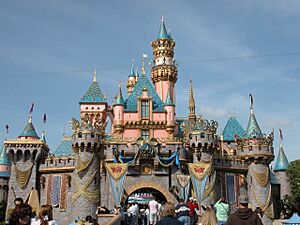
From 2005 to 2006, Disneyland celebrated its 50th anniversary with the "Happiest Homecoming on Earth." The park got major updates, and many classic rides were restored. Sleeping Beauty Castle was decorated with a large "60" logo for the 60th Diamond Celebration in 2015. New parades and fireworks shows were also part of this celebration.
COVID-19 Closure
Disneyland Park closed on March 14, 2020, because of the COVID-19 pandemic. It stayed closed for over a year. Downtown Disney reopened in July 2020. The parks were supposed to reopen on Disneyland's 65th birthday, but it was delayed. In February 2021, Disneyland offered a special event called "A Touch of Disney." Guests could shop and eat in parts of the park. Disneyland and Disney California Adventure officially reopened on April 30, 2021. They had fewer guests and safety rules like masks. On June 15, 2021, the parks were allowed to return to full capacity.
Disneyland Today
In 2021, Disney announced a plan called DisneylandForward. This plan aims to expand the park with more rides, restaurants, and shops. The city of Anaheim approved this plan in May 2024.
On January 27, 2023, Disneyland started a year-long celebration for The Walt Disney Company's 100th birthday, called Disney100. New attractions like Mickey & Minnie's Runaway Railway and the Wondrous Journeys fireworks show debuted.
In April 2023, Disneyland held its first official "Pride Nite" to support the LGBTQ community. This was 25 years after the first unofficial 'Gay Day' at Disneyland.
Park Layout and Attractions
<mapframe width="250" height="280" latitude="33.8133" longitude="-117.920" zoom="15" text="Disneyland layout. Main Street, U.S.A. (cyan), Adventureland (orange), New Orleans Square (yellow), Frontierland (green), Star Wars: Galaxy's Edge (red), Fantasyland (magenta) and Tomorrowland (blue)"> [ { "type": "ExternalData", "service": "geomask", "ids": "Q181185", "properties": {"fill":"#ffffff", "fill-opacity": 0.9, "stroke": "#ff0000", "stroke-width": 1} },
{ "type": "ExternalData", "service": "geoshape", "ids": "Q67002373", "properties": {"fill":"#ff0000", "fill-opacity": 0.4, "stroke": "#ff0000", "stroke-width": 0, "title": "Star Wars: Galaxy's Edge"} },
{ "type": "ExternalData", "service": "geoshape", "ids": "Q49986414", "properties": {"fill":"#0000ff", "fill-opacity": 0.4, "stroke": "#0000ff", "stroke-width": 0, "title": "Tomorrowland"} },
{ "type": "ExternalData", "service": "geoshape", "ids": "Q50179619", "properties": {"fill":"#00ff00", "fill-opacity": 0.4, "stroke": "#00ff00", "stroke-width": 0, "title": "Frontierland"} },
{ "type": "ExternalData", "service": "geoshape", "ids": "Q49967255", "properties": {"fill":"#ff00ff", "fill-opacity": 0.4, "stroke": "#ff00ff", "stroke-width": 0, "title": "Fantasyland"} },
{ "type": "ExternalData", "service": "geoshape", "ids": "Q2917588", "properties": {"fill":"#ffff00", "fill-opacity": 0.4, "stroke": "#ffff00", "stroke-width": 0, "title": "New Orleans Square"} },
{ "type": "ExternalData", "service": "geoshape", "ids": "Q50180234", "properties": {"fill":"#FF6600", "fill-opacity": 0.4, "stroke": "#FF6600", "stroke-width": 0, "title": "Adventureland"} },
{ "type": "ExternalData", "service": "geoshape", "ids": "Q49981281", "properties": {"fill":"#00FFFF", "fill-opacity": 0.4, "stroke": "#00FFFF", "stroke-width": 0, "title": "Main Street USA"} } ] </mapframe> Disneyland Park has nine themed "lands" and covers over 100 acres. When it opened, it had Main Street, USA, Adventureland, Frontierland, Fantasyland, and Tomorrowland. Later, New Orleans Square (1966), Bayou Country (1972), Mickey's Toontown (1993), and Star Wars: Galaxy's Edge (2019) were added. You can find "Hidden Mickeys" all over the park. These are subtle shapes of Mickey Mouse's head hidden in the designs. A Disneyland Railroad train circles the entire park.
- Lands of Disneyland
-
Frontierland
(Big Thunder Mountain Railroad) -
Fantasyland
(Peter Pan's Flight in the foreground and the Matterhorn Bobsleds in the background) -
Tomorrowland
(Space Mountain in 2010)
Main Street, USA
Main Street, USA looks like a small American town from the early 1900s. It was inspired by Walt Disney's hometown, Marceline, Missouri. Here you'll find a train station, shops, and even a firehouse. Walt Disney had a secret apartment above the firehouse. At the end of Main Street is Sleeping Beauty Castle. This castle leads to Fantasyland. Other lands like Adventureland, Frontierland, and Tomorrowland are also nearby. The design of Main Street uses a trick called forced perspective. Buildings look taller than they really are.
Adventureland
Adventureland feels like an exotic jungle in a faraway land. Popular attractions include Jungle Cruise and the Indiana Jones Adventure. You can also explore the Adventureland Treehouse. This was inspired by Walt Disney's 1960 film Swiss Family Robinson. Walt Disney's Enchanted Tiki Room opened in 1963. It was the first ride to use Audio-Animatronics, which are moving robots.
Frontierland
Frontierland takes you back to the pioneer days of the American West. You can see animatronic Native Americans along the Rivers of America. Exciting rides include Big Thunder Mountain Railroad. You can also ride the Mark Twain Riverboat or the Sailing Ship Columbia. Explore Pirate's Lair on Tom Sawyer Island. Don't miss the nighttime show Fantasmic!. Frontierland also has the Golden Horseshoe Saloon, an Old West-style show hall.
Fantasyland
Fantasyland is home to many classic storybook rides. You can go on Snow White's Enchanted Wish, Peter Pan's Flight, and It's a Small World. Other favorites include Mr. Toad's Wild Ride and Alice in Wonderland. The area also has King Arthur Carrousel and Mad Tea Party. Inside Sleeping Beauty Castle, you can walk through a story about the 1959 film Sleeping Beauty.
Tomorrowland
Tomorrowland has a cool "retro-future" theme. It looks like what people in the past imagined the future would be. Attractions include Space Mountain and Autopia. You can also find Star Wars Launch Bay and Buzz Lightyear Astro Blasters. The Disneyland Monorail and Finding Nemo Submarine Voyage are here too.
New Orleans Square
New Orleans Square is designed like 19th-century New Orleans. It's home to two famous rides: Pirates of the Caribbean and the Haunted Mansion. This area also has a secret private club called Club 33.
Bayou Country
Bayou Country was first called Bear Country, then Critter Country. In 2024, it became Bayou Country. The main attraction here is the log flume ride Tiana's Bayou Adventure. You can also find The Many Adventures of Winnie the Pooh.
Mickey's Toontown
Mickey's Toontown looks like a cartoon world from the 1930s. It was inspired by the movie Who Framed Roger Rabbit. Here you can meet Disney's classic cartoon characters. Toontown has three rides: Chip 'n' Dale's Gadgetcoaster, Mickey & Minnie's Runaway Railway, and Roger Rabbit's Car Toon Spin. You can also visit Mickey's House and Meet Mickey and Minnie's House.
Star Wars: Galaxy's Edge
Star Wars: Galaxy's Edge takes you to the Star Wars universe. It's set in the Black Spire Outpost village on the planet Batuu. The main attractions are the Millennium Falcon: Smugglers Run and Star Wars: Rise of the Resistance. This land replaced an area called Big Thunder Ranch.
Park Operations
Transportation
Walt Disney loved trains! He even had a miniature railroad in his backyard. That's why a train has always been a key part of Disneyland. The Disneyland Railroad (DRR) circles the park. It uses five old-fashioned steam-powered locomotives. The train makes stops at Main Street Station, New Orleans Square Station, Mickey's Toontown Depot, and Tomorrowland Station. The ride also takes you past the "Grand Canyon/Primeval World" dioramas.
Another famous ride is the Disneyland Monorail. It opened in Tomorrowland in 1959. It was the first daily-operating monorail in the Western Hemisphere. The monorail takes visitors between a station inside Tomorrowland and one in Downtown Disney. It's a 2.5-mile ride that gives you great views of the park.
The vehicles on Main Street, U.S.A. look like cars from the early 1900s. These include horse-drawn streetcars, a double-decker bus, a fire engine, and old-fashioned automobiles. You can take a one-way ride on these vehicles down Main Street. Walt Disney himself used to drive the fire engine around the park before it opened.
Live Entertainment
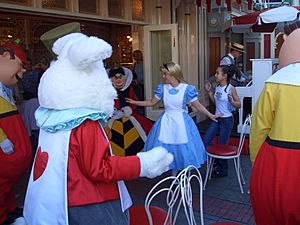
Disneyland offers lots of live entertainment. You can often find Disney, Pixar, and Star Wars characters greeting guests. Every evening, there's a flag retreat ceremony to lower the U.S. Flag. The Disneyland Band plays music on Main Street, U.S.A. During the holiday season, there's a special Disney's Candlelight Processional.
Parades
Disneyland has many different parades that travel down Main Street. These parades celebrate Disney films or holidays. They feature characters, music, and big floats. The Main Street Electrical Parade was very popular. For Disneyland's 50th anniversary, "Walt Disney's Parade of Dreams" was shown. During Christmas, you can see "A Christmas Fantasy" Parade. "Paint the Night" was a nighttime parade for the park's 60th anniversary. The "Magic Happens" parade returned to Disneyland in spring 2023.
Fireworks Shows
Fireworks shows light up the sky above Sleeping Beauty Castle. They are set to Disney songs and sometimes feature characters like Tinker Bell flying. Since 2000, the shows have become even more amazing. They use new fireworks and special effects. In 2004, Disneyland started using a new system that makes less smoke and noise. This is better for the environment.
- Regular fireworks shows:
- Fantasy in the Sky (1958–1999; 2015)
- Believe... There's Magic in the Stars (2000–2004)
- Remember... Dreams Come True (2005–2014; 2017–2019)
- Disneyland Forever (2019 and 2022 summer)
- Seasonal fireworks shows:
- Halloween Screams (August to October)
- Disney's Celebrate America: A 4th of July Concert in the Sky (Independence Day Week)
- Believe... In Holiday Magic (November to January)
- Special fireworks shows
- Wondrous Journeys (Disney100 and 70th Anniversary)
Disneyland often changes its fireworks shows. During quieter times of the year, fireworks are only on weekends. During busy times, like summer or holidays, they are shown nightly. Weather, especially strong winds, can sometimes cause shows to be delayed or canceled.
Attendance
| {{{thumb}}} | {{{right}}} | {{{480px}}} | {{{Annual attendance at Disneyland Park.}}} | ||||||||||||||||||||
|
|||||||||||||||||||||||||||||||||||||||||||||||||||||||||||||||||||||||||||||||||||||||||||||||||||||||||||||||||||||||||||||||||||||||||||||||||||||||||||||||||||||||||||||||||||
Tickets and Admission
From opening day until 1982, you paid a small fee to enter the park. Then, you bought separate tickets for each ride. These tickets were labeled "A" through "E." "A" tickets were for smaller rides, and "E" tickets were for the most popular ones. Even today, people sometimes call the best rides "E ticket attractions."
In 1982, Disneyland changed to "passports." This meant you paid one price to enter and could go on all the rides as many times as you wanted. This made things simpler for guests. Later, Disneyland added multi-day passes and Annual Passes. In 1999, the FastPass system was introduced. It let guests reserve a time for a ride to skip the long lines. This system has since been replaced by Genie+ and Lightning Lanes, which cost extra. In October 2024, Disney started testing a "Lightning Lane Premier Pass." This pass lets guests use a faster line for any ride once per day, for an extra fee.
Since 2016, Disneyland has used different prices for tickets. Prices change based on how busy the park is expected to be. "Value" days are cheaper, usually on weekdays when school is in session. "Peak" days are more expensive, like holidays and busy weekends.
| {{{thumb}}} | {{{right}}} | {{{400px}}} | |||||||||||||||
| Date | 1981 | June 1982 | October 1983 | May 1984 | January 1985 | May 1985 | ||||
|---|---|---|---|---|---|---|---|---|---|---|
| Price US$ | $10.75 | $12.00 | $13.00 | $14.00 | $15.00 | $16.50 | ||||
| Date | March 1986 | January 1987 | September 1987 | December 1988 | December 1989 | November 1990 | ||||
| Price US$ | $17.95 | $20.00 | $21.50 | $23.50 | $25.50 | $27.50 | ||||
| Date | June 1992 | May 1993 | May 1994 | January 1995 | January 1996 | March 1997 | ||||
| Price US$ | $28.75 | $30.00 | $31.00 | $33.00 | $34.00 | $36.00 | ||||
| Date | January 1998 | January 5, 1999 | January 5, 2000 | November 6, 2000 | March 19, 2002 | January 6, 2003 | ||||
| Price US$ | $38.00 | $39.00 | $41.00 | $43.00 | $45.00 | $47.00 | ||||
| Date | March 28, 2004 | January 10, 2005 | June 20, 2005 | January 4, 2006 | September 20, 2006 | September 21, 2007 | ||||
| Price US$ | $49.75 | $53.00 | $56.00 | $59.00 | $63.00 | $66.00 | ||||
| Date | August 3, 2008 | August 2, 2009 | August 8, 2010 | June 12, 2011 | May 20, 2012 | June 18, 2013 | ||||
| Price US$ | $69.00 | $72.00 | $76.00 | $80.00 | $87.00 | $92.00 | ||||
| Date | May 18, 2014 | February 22, 2015 | February 28, 2016 | February 12, 2017 | February 11, 2018 | January 6, 2019 | ||||
| Price US$ | $96.00 | $99.00 | $95/$105/$119 | $97/$110/$124 | $97/$117/$135 | $104/$129/$149 | ||||
| Date | February 11, 2020 | October 25, 2021 | October 11, 2022 | |||||||
| Price US$ | $104/$114/$124/$139/$154 | $104/$119/$134/$149/$159/$164 | $104/$114/$129/$144/$159/$169/$179 | |||||||
| Date | October 11, 2023 | October 9, 2024 | ||||||||
| Price US$ | $104/$119/$134/$159/$169/$184/$194 | $104/$126/$142/$164/$180/$196/$206 | ||||||||
Park Closures
Disneyland has closed unexpectedly a few times:
- In 1963, for mourning after a national tragedy.
- In 1970, due to a large gathering.
- In 1987 and 1992, because of winter storms.
- In 2001, after the September 11 attacks.
- From 2020 to 2021, due to the COVID-19 pandemic.
The park also has planned closures. In its early years, it sometimes closed on Mondays and Tuesdays during quieter seasons. This helped save costs for Disneyland and nearby Knott's Berry Farm. Disneyland also closes early for special events, like private parties or media events. Guests are always told about these early closures.
Seasonal Fun and Promotions
Every October, Disneyland celebrates Halloween. The park is decorated with a spooky theme. Rides like Space Mountain and the Haunted Mansion get special Halloween makeovers. There's also a special Halloween party on select nights.
From early November until January, the park is decorated for the holidays. You can see the Believe... In Holiday Magic fireworks show. The A Christmas Fantasy Parade is also a favorite. The Haunted Mansion and It's a Small World get holiday decorations. Sleeping Beauty Castle looks like it's covered in snow and sparkles with colorful lights.
See also
 In Spanish: Disneyland para niños
In Spanish: Disneyland para niños
- List of Disney theme park attractions
- List of incidents at Disneyland Resort
- Rail transport in Walt Disney Parks and Resorts


